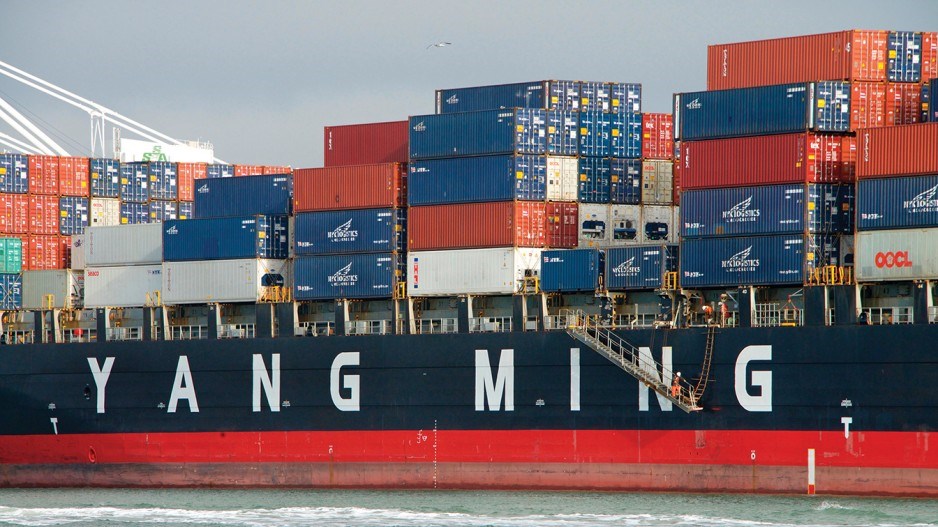2016’s dark clouds remain, but there are brighter days ahead for ocean container carriers and container ship leasing companies like Vancouver’s Seaspan Corp. (NYSE:SSW).
That’s the updated 2017 analyst forecast following a disastrous year in which major global container shipping lines collectively lost US$13 billion. The losses, as estimated in a Journal of Commerce container shipping white paper, resulted in part from a freight rate war in 2016’s first half that cut container rates to record lows.
The bottom-line result for Seaspan, the world’s largest independent container ship lease company, was a net loss of US$139 million on revenue of US$878 million in 2016 compared with net earnings of US$199 million on revenue of US$819 million in 2015 and US$299 million on US$677 million in 2013.
Seaspan’s precipitous skid from profit to loss resulted from several factors, including the bankruptcy of South Korea’s Hanjin Shipping, which was the world’s seventh-largest container shipping line, and charter rates for a benchmark 4,000 20-foot equivalent unit (TEU) capacity ship, which dropped to US$4,200 per day by year’s end from a high of US$6,000.
The Hanjin financial shipwreck stranded about US$18.9 million in Seaspan’s accounts receivable.
Concerns have also been raised recently over the financial health of Taiwan’s Yang Ming Marine Transport Corp. The world’s ninth-largest container line leases nine Seaspan ships and accounted for 13.8% of its 2016 revenue.
According to global shipping data company Alphaliner, Yang Ming’s net debt-to-equity ratio was 486% at the end of 2016. It also noted that Yang Ming had held an extraordinary shareholders meeting on December 22, 2016, to consolidate the company’s stock and write off US$527 million in accumulated losses.
But Seaspan CEO Gerry Wang is optimistic about the year ahead.
In an April 28 earnings call, he cited “very encouraging signs of improving market conditions” over the past few months.
They include the Shanghai container shipping freight index being up more than 70% compared with last year, higher-than-expected Europe-to-Asia trade and increased Asian demand for consumer goods and infrastructure spending.
Shipping analysts share Wang’s cautious optimism.
A recent 2017 outlook update from Drewry, a U.K.-based shipping consultancy, noted that 2016’s fourth quarter was stronger than anticipated for container lines.
The year has also started better for otherwise troubled carriers. For example, Yang Ming’s 2017 first-quarter revenue was up 11.6%, and its net loss was down 75% to US$29 million compared with the same quarter in 2016.
Neil Dekker, Drewry’s director of container research, added that the 10% fourth-quarter growth in transpacific trade was “a very strong end to the year.”
In a release following the outlook update, Drewry noted that global container traffic surged 10% higher in 2017’s first quarter compared with the same period in 2016.
In the April update, Dekker said Drewry is forecasting slightly stronger demand for 2017 and marginally reduced container capacity in what has been a significantly oversupplied shipping sector.
Increased scrapping of older container ships has reduced that supply; deferred delivery of new ships has also helped, at least temporarily.
In 2015, carriers placed orders for ships that would add about 2.1 million TEUs of capacity to the global fleet’s 20.3 million TEUs. Most were to be delivered in 2017. In 2016, only 250,000 TEUs were ordered.
However, many larger container ships are scheduled to be added to the fleet in 2018, which could again inflate capacity and erode container shipping rates.
Seaspan, which had planned to add two new 10,000-TEU vessels to its 88-ship operating fleet later this year, has deferred their delivery until early 2018.
However, Wang said, the company could take delivery of the ships earlier if market conditions were right.
Thus far those conditions have been far from right.
Seaspan’s first-quarter 2017 numbers showed earnings of US$31.8 million on revenue of US$201 million compared with US$46 million on revenue of US$216 million in 2016’s first quarter.
Adjusted first-quarter EBITDA (earnings before interest, tax, depreciation and amortization) was approximately $119.3 million, a $43.3 million decrease from Q1 2016.
The company is forecasting second-quarter revenue of between $203 million and $207 million.
Charter rates for container ships are recovering, but Simon Heaney, Drewry’s senior manager of container research, said that while “carriers are once again price givers rather than price takers … they are fighting against a long-term downturn in rates” and need a long run of above-average spot market rates to fully recover.
A return to a relatively normal market that would reduce carriers’ payloads of red ink will therefore take longer and require a significant improvement in supply-and-demand fundamentals.
Heaney said 2016’s stronger finish and 2017’s brighter outlook could return the global container carrier sector to profit of between US$1.5 billion and US$3.3 billion this year.
But that upbeat outlook is contingent upon container supply and demand, the global economy and a host of other factors.
While he echoed Dekker’s view of a more positive outlook for 2017, Heaney said there’s little room for error. A sudden spike in bunker fuel costs or another rate war in any key trade corridor could “condemn many of the carriers to another year of loss making.”
“Profitability,” he said, “is on a bit of a knife-edge this year. It could go either way.”
@timothyrenshaw




